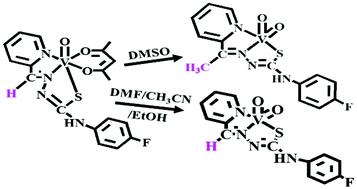Synthesis, structure, solution behavior, reactivity and biological evaluation of oxidovanadium(iv/v) thiosemicarbazone complexes†
Abstract
The synthesis and characterization of an oxidovanadium(IV) [VIVO(L)(acac)] (1) and of two dioxidovanadium(V) [VVO2(L′)] (2) and [VVO2(L)] (2a) complexes of the Schiff base formed from the reaction of 4-(p-fluorophenyl) thiosemicarbazone with pyridine-2-aldehyde (HL) are described. The oxidovanadium(IV) species [VIVO(L)(acac)] (1) was synthesized by the reaction of VIVO(acac)2 with the thiosemicarbazone HL in refluxing ethanol. The recrystallization of [VIVO(L)(acac)] (1) in DMF, CH3CN or EtOH gave the same product i.e. the dioxidovanadium(V) complex [VVO2(L)] (2a); however, upon recrystallization of 1 in DMSO a distinct compound [VVO2(L′)] (2) was formed, wherein the original ligand L− is transformed to a rearranged one, L′−. In the presence of DMSO the ligand in complex 1 is found to undergo methylation at the carbon centre attached to imine nitrogen (aldimine) and transformed to the corresponding VVO2-species through in situ reaction. The synthesized HL and the metal complexes were characterized by elemental analysis, IR, UV–Vis, NMR and EPR spectroscopy. The molecular structure of [VVO2(L′)] (2) was determined by single crystal X-ray crystallography. The methylation of various other ligands and complexes prepared from different vanadium precursors under similar reaction conditions was also attempted and it was confirmed that the imine methylation observed is both ligand and metal precursor specific. Complexes 1 and 2 show in vitro insulin-like activity against insulin responsive L6 myoblast cells, higher than VIVO(acac)2, with complex 1 being more potent. In addition, the in vitro cytotoxicity studies of HL, and of complexes 1 and 2 against the MCF-7 and Vero cell lines were also done. The ligand is not cytotoxic and complex 2 is significantly more cytotoxic than 1. DAPI staining experiments indicate that an increase in the time of incubation and an increase of concentration of the complexes lead to the increase in cell death.



 Please wait while we load your content...
Please wait while we load your content...